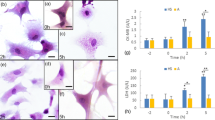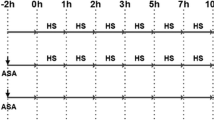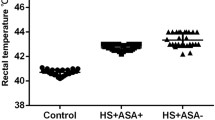Abstract
To understand the potential association of heat stress resistance with HspB1 induction by aspirin (ASA) in chicken myocardial cells, variations of HspB1 expression and heat stressed-induced damage of myocardial cells after ASA administration were studied in primary cultured myocardial cells. Cytopathological lesions as well as damage-related enzymes, such as creatine kinase-MB (CK-MB) and lactate dehydrogenase (LDH), indicated the considerable protective ability of ASA pre-treatment against acute heat stress. Immunostaining assays showed that heat stress caused HspB1 to relocate into the nucleus, while ASA did not. ELISA analysis, revealed that HspB1 expression induced by ASA averaged 45.62-fold higher than that of the control. These results indicated that the acute heat-stressed injuries were accompanied by comparatively lower HspB1 expression caused by heat stress in vitro. ASA pre-treatment induced a level of HspB1 presumed to be sufficient to protect myocardial cells from acute heat stress in the extracorporal model, although more detailed mechanisms will require further investigation.




Similar content being viewed by others
References
Adhikari AS, Sridhar Rao K, Rangaraj N, Parnaik VK, Mohan Rao C (2004) Heat stress-induced localization of small heat shock proteins in mouse myoblasts: intranuclear lamin A/C speckles as target for alphaB-crystallin and Hsp25. Exp Cell Res 299:393–403. doi:10.1016/j.yexcr.2004.05.032
Amani M, Jeddi S, Ahmadiasl N, Usefzade N, Zaman J (2013) Effect of HEMADO on level of CK-MB and LDH enzymes after ischemia/reperfusion injury in isolated rat heart. Bio Impacts BI 3:101–104. doi:10.5681/bi.2013.003
Amberger A, Hala M, Saurwein-Teissl M, Metzler B, Grubeck-Loebenstein B, Xu Q, Wick G (1999) Suppressive effects of anti-inflammatory agents on human endothelial cell activation and induction of heat shock proteins. Mol Med 5:117–128
Arrigo APaL J (1994) Expression and function of the low-molecular-weight heat shock proteins. In: Morimoto RI, Tissieres A, Georgopoulos C (eds) The biology of heat shock proteins and molecular chaperones., pp 335–373
Arrigo AP, Suhan JP, Welch WJ (1988) Dynamic changes in the structure and intracellular locale of the mammalian low-molecular-weight heat shock protein. Mol Cell Biol 8:5059–5071
Benn SC et al (2002) Hsp27 upregulation and phosphorylation is required for injured sensory and motor neuron survival. Neuron 36:45–56
Bryantsev AL, Loktionova SA, Ilyinskaya OP, Tararak EM, Kampinga HH, Kabakov AE (2002) Distribution, phosphorylation, and activities of Hsp25 in heat-stressed H9c2 myoblasts: a functional link to cytoprotection. Cell Stress Chaperones 7:146–155
Chen TH, Yang YC, Wang JC, Wang JJ (2013) Curcumin treatment protects against renal ischemia and reperfusion injury-induced cardiac dysfunction and myocardial injury. Transplant Proc 45:3546–3549. doi:10.1016/j.transproceed.2013.09.006
Chen H, Adam A, Cheng Y, Tang S, Hartung J, Bao E (2015) Localization and expression of heat shock protein 70 with rat myocardial cell damage induced by heat stress in vitro and in vivo. Mol Med Rep 11:2276–2284. doi:10.3892/mmr.2014.2986
Chon H, Lee S, Yoon SY, Lee EK, Chang SI, Choo J (2013) SERS-based competitive immunoassay of troponin I and CK-MB markers for early diagnosis of acute myocardial infarction Chem Commun (Camb) doi:10.1039/c3cc47850e
de Graauw M, Tijdens I, Cramer R, Corless S, Timms JF, van de Water B (2005) Heat shock protein 27 is the major differentially phosphorylated protein involved in renal epithelial cellular stress response and controls focal adhesion organization and apoptosis. J Biol Chem 280:29885–29898. doi:10.1074/jbc.M412708200
Deharo P et al. (2014) Fixed-dose aspirin-clopidogrel combination enhances compliance to aspirin after acute coronary syndrome Int J Cardiol doi:10.1016/j.ijcard.2013.12.194
Ebert MP et al (2005) Protective role of heat shock protein 27 in gastric mucosal injury. J Pathol 207:177–184. doi:10.1002/path.1815
Ellis FP (1972) Mortality from heat illness and heat-aggravated illness in the United States. Environ Res 5:1–58
Faiella L, Piaz FD, Bisio A, Tosco A, De Tommasi N (2012) A chemical proteomics approach reveals Hsp27 as a target for proapoptotic clerodane diterpenes. Mol Bio Syst 8:2637–2644. doi:10.1039/c2mb25171j
Gao Z et al (2013) Inhibition of heat-induced apoptosis in rat small intestine and IEC-6 cells through the AKT signaling pathway. BMC Vet Res 9:241. doi:10.1186/1746-6148-9-241
Hollander JM, Martin JL, Belke DD, Scott BT, Swanson E, Krishnamoorthy V, Dillmann WH (2004) Overexpression of wild-type heat shock protein 27 and a nonphosphorylatable heat shock protein 27 mutant protects against ischemia/reperfusion injury in a transgenic mouse model. Circulation 110:3544–3552. doi:10.1161/01.CIR.0000148825.99184.50
Javeed A, Hou Y, Duan K, Zhang B, Shen H, Cao Y, Zhao Y (2011) Aspirin significantly decreases the nonopsonic phagocytosis and immunogenicity of macrophages in mice. Inflamm Res 60:389–398. doi:10.1007/s00011-010-0283-4
Kamboh AA, Hang SQ, Bakhetgul M, Zhu WY (2013) Effects of genistein and hesperidin on biomarkers of heat stress in broilers under persistent summer stress. Poult Sci 92:2411–2418. doi:10.3382/ps.2012-02960
Kato K, Hasegawa K, Goto S, Inaguma Y (1994) Dissociation as a result of phosphorylation of an aggregated form of the small stress protein, hsp27. J Biol Chem 269:11274–11278
Knauf U, Newton EM, Kyriakis J, Kingston RE (1996) Repression of human heat shock factor 1 activity at control temperature by phosphorylation. Genes Dev 10:2782–2793
Lambert H, Charette SJ, Bernier AF, Guimond A, Landry J (1999) HSP27 multimerization mediated by phosphorylation-sensitive intermolecular interactions at the amino terminus. J Biol Chem 274:9378–9385
Lappas GD, Karl IE, Hotchkiss RS (1994) Effect of ethanol and sodium arsenite on HSP-72 formation and on survival in a murine endotoxin model. Shock 2:34–39, discussion 40
Lianos GD, Alexiou GA, Mangano A, Rausei S, Boni L, Dionigi G, Roukos DH (2015) The role of heat shock proteins in cancer. Cancer Lett 360:114–118. doi:10.1016/j.canlet.2015.02.026
Lindquist S (1986) The heat-shock response. Annu Rev Biochem 55:1151–1191. doi:10.1146/annurev.bi.55.070186.005443
Liu L et al (2007) Over-expression of heat shock protein 27 attenuates doxorubicin-induced cardiac dysfunction in mice. Eur J Heart Fail 9:762–769. doi:10.1016/j.ejheart.2007.03.007
Loktionova SA, Ilyinskaya OP, Gabai VL, Kabakov AE (1996) Distinct effects of heat shock and ATP depletion on distribution and isoform patterns of human Hsp27 in endothelial cells. FEBS Lett 392:100–104
Ma X et al. (2013) Heat shock protein 27 attenuates neointima formation and accelerates reendothelialization after arterial injury and stent implantation: importance of vascular endothelial growth factor up-regulation FASEB journal: official publication of the Federation of American Societies for Experimental Biology doi:10.1096/fj.13-230417
Mahaffey KW et al. (2013) Association of aspirin dose and vorapaxar safety and efficacy in patients with non-ST-segment elevation acute coronary syndrome (from the TRACER Trial) the American journal of cardiology doi:10.1016/j.amjcard.2013.11.052
Morimoto RI, Sarge KD, Abravaya K (1992) Transcriptional regulation of heat shock genes. A paradigm for inducible genomic responses. J Biol Chem 267:21987–21990
Patrono C, Garcia Rodriguez LA, Landolfi R, Baigent C (2005) Low-dose aspirin for the prevention of atherothrombosis. N Engl J Med 353:2373–2383. doi:10.1056/NEJMra052717
Piestun Y, Druyan S, Brake J, Yahav S (2013) Thermal manipulations during broiler incubation alter performance of broilers to 70 days of age. Poult Sci 92:1155–1163. doi:10.3382/ps.2012-02609
Rhoads ML, Kim JW, Collier RJ, Crooker BA, Boisclair YR, Baumgard LH, Rhoads RP (2010) Effects of heat stress and nutrition on lactating Holstein cows: II. Aspects of hepatic growth hormone responsiveness. J Dairy Sci 93:170–179. doi:10.3168/jds.2009-2469
Ribeiro SP, Villar J, Downey GP, Edelson JD, Slutsky AS (1994) Sodium arsenite induces heat shock protein-72 kDa expression in the lungs and protects rats against sepsis. Crit Care Med 22:922–929
Rogalla T et al (1999) Regulation of Hsp27 oligomerization, chaperone function, and protective activity against oxidative stress/tumor necrosis factor alpha by phosphorylation. J Biol Chem 274:18947–18956
Sandoval-Montiel AA, Zentella-de-Pina M, Ventura-Gallegos JL, Frias-Gonzalez S, Lopez-Macay A, Zentella-Dehesa A (2013) HSP-72 accelerated expression in mononuclear cells induced in vivo by acetyl salicylic acid can be reproduced in vitro when combined with H2O2. PLoS One 8:e65449. doi:10.1371/journal.pone.0065449
Saravanan G, Ponmurugan P, Sathiyavathi M, Vadivukkarasi S, Sengottuvelu S (2013) Cardioprotective activity of Amaranthus viridis Linn: effect on serum marker enzymes, cardiac troponin and antioxidant system in experimental myocardial infarcted rats. Int J Cardiol 165:494–498. doi:10.1016/j.ijcard.2011.09.005
Scheers-Masters JR, Schootman M, Thach BT (2004) Heat stress and sudden infant death syndrome incidence: a United States population epidemiologic study. Pediatrics 113:e586–592
Schweiger T et al (2015) Stromal expression of heat-shock protein 27 is associated with worse clinical outcome in patients with colorectal cancer lung metastases. PLoS One 10:e0120724. doi:10.1371/journal.pone.0120724
Solomon DH, Glynn RJ, Levin R, Avorn J (2002) Nonsteroidal anti-inflammatory drug use and acute myocardial infarction. Arch Intern Med 162:1099–1104
N. R. St-Pierre* BC, and G. Schnitkey† (2003) Economic losses from heat stress by US livestock industries. J Dairy Sci 86:E52–E77
Tang S et al (2013) Localization and expression of Hsp27 and alphaB-crystallin in rat primary myocardial cells during heat stress in vitro. PLoS One 8:e69066. doi:10.1371/journal.pone.0069066
Wu NC, Chen TH, Yang YC, Liao FT, Wang JC, Wang JJ (2013) N-acetylcysteine improves cardiac contractility and ameliorates myocardial injury in a rat model of lung ischemia and reperfusion injury. Transplant Proc 45:3550–3554. doi:10.1016/j.transproceed.2013.09.005
Wu D et al. (2015) Acetyl salicylic acid protected against heat stress damage in chicken myocardial cells and may associate with induced Hsp27 expression cell stress & chaperones doi:10.1007/s12192-015-0596-x
Yan J, Bao E, Yu J (2009) Heat shock protein 60 expression in heart, liver and kidney of broilers exposed to high temperature. Res Vet Sci 86:533–538. doi:10.1016/j.rvsc.2008.09.002
Yu J, Tang S, Bao E, Zhang M, Hao Q, Yue Z (2009) The effect of transportation on the expression of heat shock proteins and meat quality of M. longissimus dorsi in pigs. Meat Sci 83:474–478. doi:10.1016/j.meatsci.2009.06.028
Zeren G et al (2013) [Relation of heart-type fatty acid-binding protein with the degree and extent of atherosclerosis in patients with non-ST elevation acute coronary syndrome]. Turk Kardiyol Dern Ars 41:610–616. doi:10.5543/tkda.2013.26974
Zhao W, Wisniewski M, Wang W, Liu J, Liu Y (2013) Heat-induced oxidative injury contributes to inhibition of Botrytis cinerea spore germination and growth World journal of microbiology & biotechnology doi:10.1007/s11274-013-1513-z
Zuo J, Baler R, Dahl G, Voellmy R (1994) Activation of the DNA-binding ability of human heat shock transcription factor 1 may involve the transition from an intramolecular to an intermolecular triple-stranded coiled-coil structure. Mol Cell Biol 14:7557–7568
Acknowledgments
This work was supported by grants from the National Natural Science Foundation of China (31372403), the Natural Science Foundation of the Jiangsu Province (Grant No. BK20140107), the Postgraduate Student Research and Innovation Project of Jiangsu Province (KYLX15_0558), the Priority Academic Program Development of Jiangsu Higher Education Institutions (PAPD), and the Sino-German Agricultural Cooperation Project of the Federal Ministry of Food, the Agriculture and Consumer Production, Berlin, Germany.
Author information
Authors and Affiliations
Corresponding author
Additional information
Di Wu and Miao Zhang contributed equally to this work.
Rights and permissions
About this article
Cite this article
Wu, D., Zhang, M., Xu, J. et al. In vitro evaluation of aspirin-induced HspB1 against heat stress damage in chicken myocardial cells. Cell Stress and Chaperones 21, 405–413 (2016). https://doi.org/10.1007/s12192-016-0666-8
Received:
Revised:
Accepted:
Published:
Issue Date:
DOI: https://doi.org/10.1007/s12192-016-0666-8




